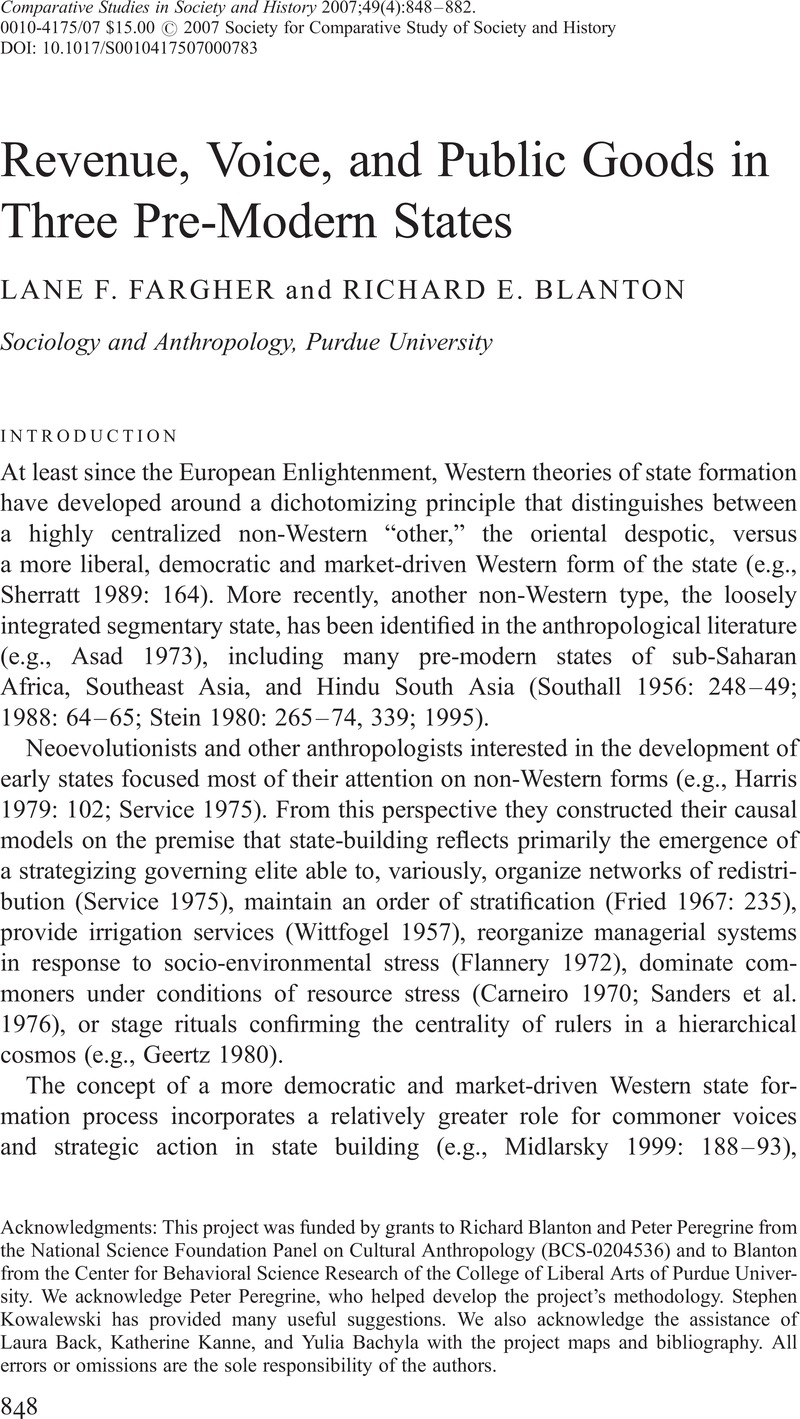Crossref Citations
This article has been cited by the following publications. This list is generated based on data provided by Crossref.
2009.
KATUNSPECIAL ISSUE: CUMULATIVE REFERENCES.
Ancient Mesoamerica,
Vol. 20,
Issue. 2,
p.
271.
Coon, Matthew S.
2009.
Variation in Ohio Hopewell Political Economies.
American Antiquity,
Vol. 74,
Issue. 1,
p.
49.
Blanton, Richard
2010.
Collective Action and Adaptive Socioecological Cycles in Premodern States.
Cross-Cultural Research,
Vol. 44,
Issue. 1,
p.
41.
Fargher, Lane F.
Blanton, Richard E.
and
Espinoza, Verenice Y. Heredia
2010.
Egalitarian Ideology and Political Power in Prehispanic Central Mexico: The Case of Tlaxcallan.
Latin American Antiquity,
Vol. 21,
Issue. 3,
p.
227.
Feinman, Gary M.
2010.
Pathways to Power.
p.
255.
Stark, Barbara L
and
Chance, John K
2011.
The Comparative Archaeology of Complex Societies.
p.
192.
Blanton, Richard E.
2011.
Cultural Transformation, Art, and Collective Action in Polity Building.
Cross-Cultural Research,
Vol. 45,
Issue. 2,
p.
106.
Feinman, Gary M.
2011.
The Comparative Archaeology of Complex Societies.
p.
21.
Fargher, Lane F.
Blanton, Richard E.
Espinoza, Verenice Y. Heredia
Millhauser, John
Xiuhtecutli, Nezahualcoyotl
and
Overholtzer, Lisa
2011.
Tlaxcallan: the archaeology of an ancient republic in the New World.
Antiquity,
Vol. 85,
Issue. 327,
p.
172.
Feinman, Gary M.
2011.
Size, Complexity, and Organizational Variation: A Comparative Approach.
Cross-Cultural Research,
Vol. 45,
Issue. 1,
p.
37.
Fargher, Lane F.
Heredia Espinoza, Verenice Y.
and
Blanton, Richard E.
2011.
Alternative pathways to power in late Postclassic Highland Mesoamerica.
Journal of Anthropological Archaeology,
Vol. 30,
Issue. 3,
p.
306.
Masson, Marilyn A.
and
Freidel, David A.
2012.
An argument for Classic era Maya market exchange.
Journal of Anthropological Archaeology,
Vol. 31,
Issue. 4,
p.
455.
Powers, Simon T.
and
Lehmann, Laurent
2014.
An evolutionary model explaining the Neolithic transition from egalitarianism to leadership and despotism.
Proceedings of the Royal Society B: Biological Sciences,
Vol. 281,
Issue. 1791,
p.
20141349.
Carballo, David M.
Roscoe, Paul
and
Feinman, Gary M.
2014.
Cooperation and Collective Action in the Cultural Evolution of Complex Societies.
Journal of Archaeological Method and Theory,
Vol. 21,
Issue. 1,
p.
98.
Fargher, Lane F.
2015.
International Encyclopedia of the Social & Behavioral Sciences.
p.
252.
Smith, Michael E.
2015.
Fiscal Regimes and the Political Economy of Premodern States.
p.
71.
Ikehara, Hugo C.
2016.
The Final Formative Period in the North Coast of Peru: cooperation during violent times.
World Archaeology,
Vol. 48,
Issue. 1,
p.
70.
Oosthuizen, Susan
2016.
Recognizing and Moving on from a Failed Paradigm: The Case of Agricultural Landscapes in Anglo-Saxon England c. AD 400–800.
Journal of Archaeological Research,
Vol. 24,
Issue. 2,
p.
179.
Oosthuizen, Susan
2016.
Beyond hierarchy: archaeology, common rights and social identity.
World Archaeology,
Vol. 48,
Issue. 3,
p.
381.
DeMarrais, Elizabeth
and
Earle, Timothy
2017.
Collective Action Theory and the Dynamics of Complex Societies.
Annual Review of Anthropology,
Vol. 46,
Issue. 1,
p.
183.



